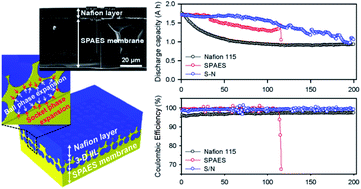A hydrocarbon/Nafion bilayer membrane with a mechanical nano-fastener for vanadium redox flow batteries
Abstract
Hydrocarbon (HC) membranes have not been successfully employed for vanadium redox flow batteries (VRFBs) due to their severe chemical degradation by highly oxidative VO2+ ions in the positive electrolyte. Protective coating of chemically stable Nafion ionomers on HC membranes can retard the degradation, but how to achieve strong interfacial adhesion of the two layers without losing proton conductivity presents a challenge. Here, we report a sulfonated poly(arylene ether sulfone) (SPAES)/Nafion bilayer membrane (S/N membrane), the interface of which is mechanically fastened by a three-dimensionally interlocked interfacial layer (3-D IIL). The 3-D IIL, which features a ball and socket joint structure, strongly binds the two chemically dissimilar membranes and thus does not generate additional interfacial resistance for proton conduction. As a result, the VRFB with the S/N membrane achieves higher coulombic and energy efficiencies than that with Nafion 115. Moreover, it can operate more than 200 cycles in contrast to a sudden membrane failure after 110 cycles for the cell with a pristine SPAES membrane, demonstrating the efficacy of this approach.



 Please wait while we load your content...
Please wait while we load your content...